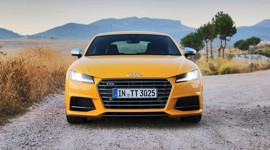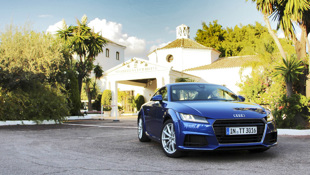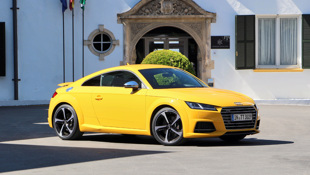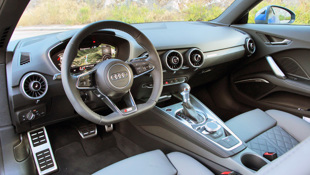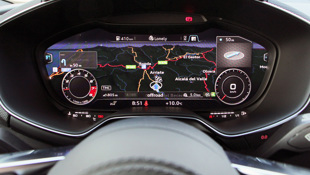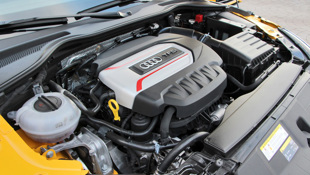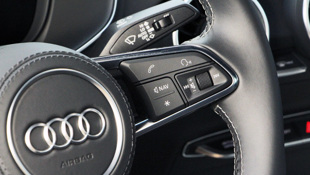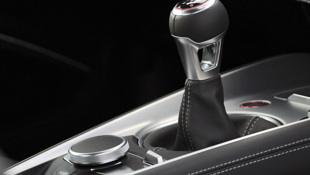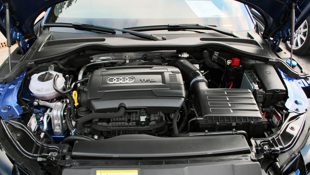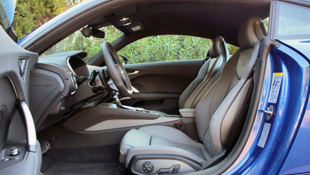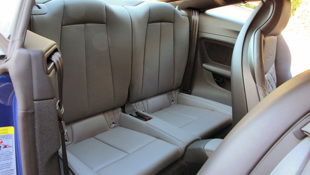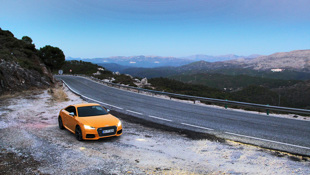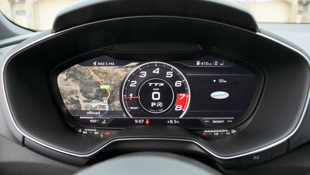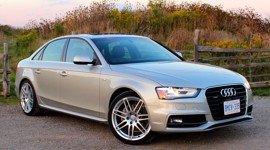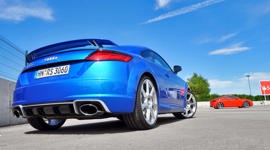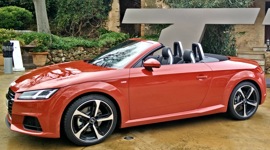Marbella, Spain – It’s hard not to be giddy getting out of Audi’s latest iteration of its sporty little coupe, greeted by the warm sunshine in Spain’s southern Andalusia region. We are here ‘testing’ Audi’s new TT, set to arrive next year as a 2016 model, bringing with it sharpened design, dynamics, and a great leap forward in its Virtual Cockpit.
Design
The original Audi TT stormed onto the scene as a design study made available to the public, and while it has evolved into a much less distinct design in the second and now third generations, it has been a positive change. The 2016 TT isn’t much of a departure at all from the second generation, the lines, angles and creases becoming sharper again, only the profile and cross section retaining the rounded, bubbly personality of the original.
While the original broke the mold with its baseball-mitt leather and stitching treatment, Audi has since discovered a more delicate touch with fine, quilted leather seats in grey or black, with tight, fine stitching and a dramatic dash with three large turbine-inspired vents with the climate controls integrated into their hubs. The materials are all Audi premium, the dash soft to the touch, the leather convincing and the switchgear finely, firmly damped.
Every little thing you touch feels right.
Audi has named their integrated infotainment and gauge cluster Virtual Cockpit, and it’s so epic that we must cover it in depth, at length, exhaustively in a column entirely to itself. The basic layout can feature large or small digital speed and tach gauges (with TTS models also offering a central tach setup) framing the info screen that would normally be housed atop or in the centre stack. Information can be accessed via thumb scrolling and buttons on the left spoke, the large dial with hand-writing recognition on the console, or voice command that Audi claims is more natural – that we’ll have to test when it lands on our shores. We found it a brilliant leap forward, the menus and layout we’ve gotten used to in our A3 long-term tester made even more easily and quickly accessible right in your line of sight.
Though overall length has increased by only 2 mm, now stretching 4,191 mm, the wheelbase gains almost 40 mm, its 2,505 mm (the shortest wheelbase of any cars using the MQB architecture underpinning VW group vehicles such as the Volkswagen Golf, Audi A3 and more) allowing for rear seats that look no more inviting than those in a Porsche 911, though officially there is more room back there for your torture victims and potted plants. Those rear seats fold down, expanding the default 305 L to 712 should you be transporting many duffel bags or groceries – the height of the compartment precludes steamer trunks and even small refrigerators. Width has increased marginally, as have front and rear track and height reduced (centre of gravity also reduced by 10 mm), boding well for handling.
Power Split
The big number is 310 hp for the TTS Coupe, with a supporting cast of 280 lb-ft of torque from 1,800 to 5,700 rpm. The base TT is no slouch either, with 230 hp and 273 lb-ft of torque from essentially the same 2.0L direct-injection turbo-four, significantly more torque than even the previous-gen TTS, which had the same 258 lb-ft as the base TT. Peak horsepower in the TT is available from 4,500–6,200 rpm, and torque from 1,600–4,300. Out on the road, the base TT impresses, pulling far harder than expected, perhaps the benefit of only 1,335 kg of mass to pull around. The TTS adds only 50 kg worth of trinkets to start at 1,385 kg. While Audi touts its sprightly 1,230 kg in base form (manual transmission, front-wheel drive), our models will likely tip the scales at the above weights owing to standard S tronic and quattro (dual clutch auto transmission and all-wheel drive). That is still a significant weight savings over the current TTS, but despite the big power increase, the TTS doesn’t feel that much more dominant with only a 7 lb-ft advantage in the torque department.
Weight savings were achieved through the aggressive use of aluminum and high strength steels in the frame, body and chassis components, as well as all the body panels, from the front fenders, side walls and the roof to the hood, doors and rear hatch.
North American TT and TTS models are expected to arrive only in S tronic automatic and Quattro AWD configuration, these parts work well together, the TTS features shorter gearing as part of its performance mission. Both models fire through the gears quickly, especially in the transmission’s Sport mode, or using the paddle shifters to call up just the right gear attacking the roads climbing through Andalusia’s hilly terrain. On one leg, we sampled the Euro-spec manual transmission, and while the shifter was precise and well weighted, the clutch felt entirely too light for a car harbouring performance aspirations. No matter the transmission, the gear lever was artfully sculpted metal tightly wrapped in leather, a joy to hold when called upon and beautiful to look at.
Beyond the transmission, the TT features Audi’s Drive Select, which adjusts the steering, transmission, throttle, suspension (when equipped with magnetic ride adaptive damping) and even quattro system between efficiency, auto and sport modes, with an individual setting should you wish to mix and match.
At first glance, I expected an experience similar to that in our A3 long-term tester, also badged 2.0T Quattro S tronic and MQB architecture at its core, but the combination of power boost, weight savings, lower centre of gravity and suspension tune elevate these same parts onto another performance plane. The torque comes on strong and early even in base TT trim, the 14.6:1 steering ratio feels more taut, eager to dive into turns, with the same crisp, light Audi signature. The suspension, combination MacPherson struts with lower wishbones in front and four links at the back, makes for a firm and occasionally jarring ride. Adaptive damping can smooth out some of the rough edges, but there’s no getting around a short-wheelbase, sporty dynamic.
Out on the track
One more lap.
It always seems, whenever we are teased with track time on a new vehicle launch, that all it would take is one more lap to really nail the line and find the chassis’ sweet spot.
That is exactly how I felt getting out of the Audi TTS in pit lane at Ascari Race Resort in the Malaga province of Spain. Realistically, it would likely take me about a thousand more laps at a variety of tracks to build the experience, and at the very least, dozens of laps learning this track and feeling out the car’s capability.
Sadly, I found myself tilting at windmills all too often on this track, charging in recklessly and completely set up wrong for half the corners of the shortened track, always one kink more than expected. So, while I failed at the track part of it, I did manage to learn something about the TTS we drove while failing. The transmission’s sport mode, while sufficient when climbing switchbacks and hillside descents, was often too slow to react when setting up for corners in an aggressive track mode. Manual mode with the paddle shifters was the only way to be prepared for a good corner exit, but even in manual mode, it upshifts at redline, so if you are a millisecond late with your own upshift you end up with a double upshift bogging you down. I’m sure more time in the car would find a nice middle ground, leaving the upshifts to the car and selecting the downshifts when needed.
Out on the road, the suspension that seemed firm and flat, began to show more pitch and dive under braking, which was phenomenal. On the flipside, the safe environment of the track meant greater liberty with the throttle and reduced stability control intervention, allowing us to experience and explore the balance of this FWD-based chassis and new tricks on offer from Audi’s Quattro AWD system. Updates to Quattro’s electronic brain mean that aggressive sport setting and deactivated stability control will prime the differential to send torque to the rear axle preemptively, mimicking rear-wheel-drive dynamics and combined with brake-based torque vectoring allowing greater corner exit speeds and a bit more rotation and less understeer. Translation: it’s pretty fun, even when you butcher the entrance and stomp on the go-pedal exiting tight corners. Play it just right, and you’ll feel the back end pushing you back onto a more desirable line.
Despite that fun, the TTS didn’t quite feel like a track-day car. Capable it is, but it felt more natural carving the canyons and sprinting by slower traffic on rare open stretches than attacking tight technical corners. The upgraded 19-inch wheels with 245/35ZR19 rubber (Hankook Ventus S1 Evo as driven) – stock on the TTS are 18-inch wheels with 245/40R18 tires – that felt in command on public roads had trouble dealing with the lateral forces in play on the track. However, the well-bolstered seat and a solid dead pedal kept me firmly placed in the seat through any cornering I managed, and the steering wheel felt light and precise at all times.
However, the final verdict is that as much as the TT is a coupe and the TTS adds a good dose of sport, neither manages to capture the sports car vibe in a way that the TTRS did ever so briefly.
The 2016 Audi TT promises even greater performance without any revolutionary changes, just a thorough reworking of every part and system. While it won’t shock anyone as did the original TT, it builds on a legacy of superb design and raises the bar for managing the relationship between the driver and the flood of information and capabilities on offer in modern vehicles.
